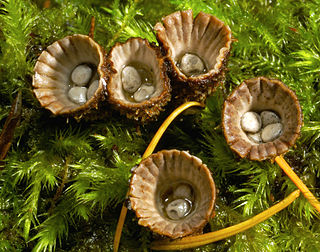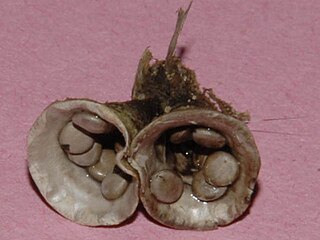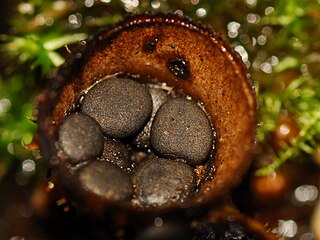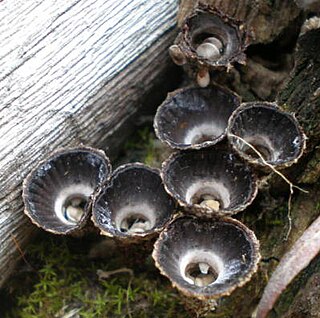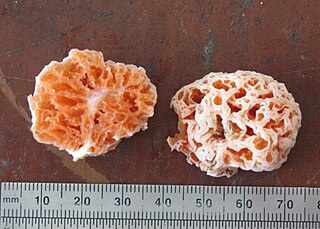Species
authority | Distribution | Dimensions
(mm tall × mm wide) | Characteristics | Spore size (μm)
shape |
|---|
| Etymology |
|---|
C. africanus [1]
H.J. Brodie (1967) | Mount Kilimanjaro (Tanzania) | 4–6 × 6–8 | experidium not plicate, woolly, hairs of equal length knotted into tight curls; endoperidium smooth with faint or irregular ridges; peridioles 2–2.5 mm in diameter, silvery with tunica | 6.5–8.5 × 8.5–12
ovoid, with a distinct apiculus |
| L. African |
C. amazonicus [2]
Trierveiler-pereira & Baseia (2009) | Brazil | 9–11 × 5–7 | experidium finely plicate, woolly, hairs yellowish brown; endoperidium distinctly plicate; peridioles 2–3 × 1.2–2 mm, dark gray and shiny | 14–19 × 12–16
subglobose |
| L. Amazon |
C. annulatus [3]
H.J. Brodie (1970) | Cypress Hills (Canada) | 7–10 × 7–12 [4] | pale brown, covered on exoperidium with tomentum; basal emplacement small and inconspicuous; endoperidium pale buff, shiny, lightly striate; lip of peridium with deep brown ring 0.5 mm wide; peridioles 1.5–1.75 mm, roughly triangular with shiny tunica [4] | 15.5–17 × 15–19 [4]
ellipsoid to ovate or roughly spherical |
| |
C. badius
Kobayasi (1937) | Japan | 8–10 × 6–8 | Exoperidium dark brown, fruiting bodies arising from wooly base 3–mm in diameter; peridioles lenticular, 2.3 mm long by 2 mm wide by 0.6–0.9 mm thick, silvery-lead colored, with tunica. [5] | 15–18 × 11–13 [5] |
| L. badius (dull brown) |
C. berkeleyanus
(Tul. & C. Tul.) Lloyd (1906) | Widespread distribution in the tropics: West Indies, Florida, Mexico, Bolivia, Brazil, Hawaiian Islands | 6–8 × 4–6 [6] | Exoperidium hairy in fresh specimens, but wears off in age, leaving surface smooth and plicate; inner surface variably plicate; peridioles dark brown, 1.5–3 mm in diameter; typically elliptical, with a thin tunica. [6] | 6–9 × 4–7 [6] |
| |
C. bulleri [7]
H.J. Brodie (1967) | West Indies, Hawaiian Islands, Mexico [4] | 5–9 × 5–8 [4] | Exoperidium with fine tomentum and long, converging downward-pointing hairs, plicate in upper third; ectoperidal surface plicate, silvery; epiphragm white with vertical tufts of hyphae; peridioles 2–2.5 mm in diameter with thick tunica, silvery when fresh, dark-brown when old. [8] | 5–8.5
spherical [8] |
| |
C. canna [9]
Lloyd (1906) | Tropical locales: Jamaica, Costa Rica, Barbados, Mexico, Mauritius | 7–8 × 6–8 [8] | Exoperidium dark brown, scabrous with short tomentum; endoperidial surface smooth, white; peridioles with thin tunica on upper side. [8] | 7–9 [8]
roughly spherical |
| L. from Gr. canna (a reed) |
C. chevalieri
Har. & Pat. (1909) | Oubangui | Up to 20 × 5–7 [10] | Resembles C. striatus | 8 × 5
ovoid [10] |
| |
C. colensoi
Berk. (1855) | New Zealand, Australia | 6–7 × 5–6 [11] | Cups bell-shaped, smooth with fine hairs pressed down on exoperidium; peridioles approximately 2 mm | Some ellipsoid, 10–12 × 8–10; some subglobose, 9–12 [11] |
| W. Colenso |
C. confusus [12]
Tai & Hung (1948) | Yunnan (China) | 11–17 × 5–9 [5] | Exterior surface light cinnamon colored, shaggy; interior surface light buff, smooth; tunica thick. | 7–10 × 5–6.4 [5]
elliptic or narrowly obovate [5] |
| L. confusus (confused) |
C. cornucopiodes [13]
T.X. Zhou & W. Ren (1992) | China | | | |
| |
C. costatus
Lloyd (1936) | Puerto Rico | 2.5–3 mm diameter [14] | Exoperidium covered with dark, strigose hairs, ribbed, plicate; peridioles small (1 mm), black. [14] | 16–× 5– [14]
elliptical |
| L. costatus (ribbed) |
C. crassimurus [15]
H.J. Brodie (1971) | Hawaii | 5 × 6–7 | Golden colored, plicate, external hairs; radially wrinkled dark brown peridioles. Has a two-layered cortex and long narrow spores. [16] | 17–20 × 11–12
ellipsoid, very thick-walled (2.5–4 μm) [17] |
| L. crassus (thick) murus (wall) |
C. crispus
H.J. Brodie (1974) [18] | Ghana | | Golden-colored, plicate peridia covered on external surface with curls of hyphal hairs | |
| |
C. earlei
Lloyd (1906) | Tropical or subtropical: Cuba, Puerto Rico, Mexico, Hawaii | 6–7 × 8 [11] | Dark brown exterior, silvery (almost white) interior surface; tomentum of short hairs; peridioles up to 2 mm wide, thin tunica on upper side [19] | 12 × 10 to 22 × 12 [20] |
| F.S. Earle |
C. ellipsoideus
H.J. Brodie (1974) [21] | Mysore India | | Pale colored and plicate; has peridioles and spores with an ellipsoidal outline. [16] | |
| |
C. elmeri
Bres. | Philippines | 7–10 × 7–9 [17] | Peridioles ash-grey, powdery, 1.3–1.5 mm in diameter; thin tunica (100–150 μm thick). [17] | 18–22 × 10–12 [17]
ellipsoidal |
| A.D.E. Elmer |
C. fimicola
Berk. (1881) | Puerto Rico, Mexico | 2–3 × 4–5 | Pale, with strigose matted hairs; peridioles small, black, 1.5 mm | 8 × 16 [22] |
| |
C. gayanus
Tul. & C. Tul. (1844) | Chile, Costa Rica, Jamaica, Venezuela | 153 × 5–6 | Narrow, conic, dark brown, inner surface striate, out surface only faintly striate; peridioles black, 3 mm with thick outer wall. | 20–32
roughly spherical [14] |
| C. Gay |
C. gracilis [23]
H.J. Brodie (1973) | Luzon (Philippines); Brazil [24] | 4–7 × 8–10 | Peridium slender, obconic, thin-walled (0.2–0.4 mm); outer surface umber- or rust-colored and covered with conical tufts of hairs, not plicate, inner surface same color as outer or lighter; epiphragm pale buff with brown hairs; peridioles 2 mm in diameter, circular. [25] | 20 × 10
ellipsoidal |
| L. gracilis (slender) |
C. griseocarpus [26]
H.J. Brodie (1984) | | | | |
| |
C. helenae
H.J. Brodie (1966) | Alpine and boreal, and dry areas of Idaho; Brazil [24] | | | 15–19 × 12–14 |
| |
C. hirtulus
B. Liu & Y.M. Li (1989) | | | | 18–25.5 × 7.5–9 |
| |
C. hookeri [27]
Berk. (1854) | India, New Zealand, Yunnan (China) | up to 14 × 10 [28] | Bell-shaped | |
| J. Hooker |
C. intermedius
(Mont.) Tul. & C. Tul. (1844) | West Indies, Florida, Mexico, Venezuela, Colombia, Philippines | 8–9 × 7–8 | Pale fawn color, when young covered with tomentum organized in nodules; peridioles about 2 mm in diameter, with a thin tunica. | 10–× 16
elliptical [29] |
| L. inter (middle) and medius (middle) |
C. jiayuguanensis
J. Yu, T.X. Zhou & L.Z. Zhao (2002) | | | | |
| |
C. julietae
H.J. Brodie (1967) | Jamaica | 7–8 × 7–8 [30] | Pale brown or yellow, obconic with straight sides, thin-walled; exoperidium not plicate, covered with very fine hairs; inside wall smooth, glossy; narrow basal emplacement; epiphragm pale brown or yellowish; peridioles black, elliptical, wrinkled on upper surface, 1.5–1.75 mm long; thin tunica, single-layered cortex. | 5–9 × 5–7
subglobose to ellipsoid, thin-walled. [30] |
| L. from the name Juliet |
C. lanatus
(H.J. Brodie) R.L. Zhao (2007) [31] | | | | |
| |
C. lijiangensis [32]
T.X. Zhou & R.L. Zhao (2004) | China | 6–9 × 3–6 | Obconic or funnel-shaped, outer surface covered by greyish-white hairs and narrow tufts, plicate externally and internally, lip not setose; peridioles 1.5–2 × 1.5–1.8 mm, depressed, mostly round or ellipsoid. | 15.5–18.5 × 11–15 |
| |
C. limbatus
Tul. & C. Tul. (1844) | British Guiana, West Indies, China, India, Africa, South America, Hawaiian Islands, Pacific Islands | 7–10 × 6–7 [14] | Dark brown color, inner and outer surfaces plicate; peridioles 2 mm wide or more, deep brown to black, shiny. Synonymous with C. cheliensis | 16–22 × 10–12 |
| L. limbatus (bordered, or fringed) |
C. luxiensis [33]
T.X. Zhou, J. Yu & Y. Hui Chen (2003) | China | | | |
| |
C. microsporus
Tul. & C. Tul. (1844) | San Domingo, Cuba, Costa Rica, Jamaica, Hawaii, Florida | 5–7 × 6–8 [8] | Obconic, exoperidium no plicate, at times hairy; endoperidium smooth or with faint ridges, but not plicate; peridioles black, about 2 mm [34] | 5–6 × 4 [8] |
| Gr. mikros (small) and spora (seed) |
C. minimus
Pat. | China | 4–5 × 4 [8] | Exoperidium covered with hairs pressed-down. Interior surface smooth. Peridioles approximately 1 mm, with a thin tunica. Single-layered cortex, 50 μm thick. | 18–20 × 10–12 [8] |
| L. minimus (smallest) |
C. montagnei
Tul. & C. Tul. (1844) | Brazil, West Indies, Central America, Venezuela, Congo, Philippines, Thailand | 7–10 × 8 [35] | dark brown, fading with age, outside hirsute, faintly plicate; inside walls widely plicate, silvery-colored Peridioles are black and shiny, with a thin tunica, cortex one-layered but may appear two-layered | 20 × 12
ellipsoid |
| for Jean P. Montagne, French mycologist |
C. nigroalbus
Lloyd (1906) | Samoa, Fiji | | | |
| |
C. novae-zeelandiae
Tul. & C. Tul. (1844) | New Zealand | | | |
| |
C. olivaceobrunneus
Tai & Hung (1948) | Yunnan (China) | 7–8 × 6 [36] | | 16–19 × 8.6–10
ellipitic, rounded at both ends |
| L. oliva (olive) and brunneus (brown) |
C. olla
(Batsch) Pers. (1801) | Common, widespread | 10–15 × 8–10 | Flared outwards towards the mouth; exoperidium grey, fine-textured; endoperidium smooth; peridioles large, up to 3.5 wide, irregularly shaped, with tunica. [37] | 10–14 × 6–8 [37] |
| L. olla (pot) |
C. pallidus
Berk. & M.A. Curtis (1868) | West Indies, Mexico, South America (Brazil and Peru), United States (Georgia and Florida), Hawaiian Islands | 5–7 × 5–7 [30] | Crucible shaped, pale buff-colored; thin and friable peridium walls; exoperidium covered with long down-ward-bent hairs; peridioles dark grey to black; 2 mm diameter; with a thin tunica. | 7.5–15 × 4–8.5 [30]
Mostly ellipsoid. |
| L. pallidus (pale-colored) |
C. pictus [38]
H.J. Brodie (1971) | Mexico | 8–9 × 5 | Outer surface with fine hairs clumped into small mounds; cinnamon brown when dry, dark brown when moist; the mouth has a distinct red-brown band (0.2–0.3 mm wide) immediately below the rim; inside wall smooth, not plicate, lead-grey; emplacement large (7 mm); peridioles situated deep in cup, black, irregular shape (1.75–2 mm wide × 2–2.5 mm long), with depression on upper side; no tunica. | 26–32
globose |
| L. picted (painted) |
C. poeppigii
Tul. & C. Tul. (1844) | Warm countries: West Indies, South America, Hawaiian Islands, Asia, Africa, China, Florida | 6–8 × 6 | Narrowly obconic, felty or shaggy, reddish brown to dark brown, almost black in age; both inner and outer surface deeply fluted or plicate; peridioles black and shiny. Synonymous with C. megasporus | 30–42 × 20–28
elliptical [39] |
| Poeppig, the collector |
C. pullus
Tai & Hung (1948) [12] | Yunnan China | | | |
| |
C. pygmaeus
Lloyd (1906) | United States: Washington State, Idaho, Nevada, Oregon, California; Santiago (Chile) | 4–4.5 × 3.5–4 | Exoperidium greyish brown, smooth, with appressed hairs; peridioles about 1 mm, with thin tunica. [11] Synonymous with C. gansuensis | 12–14 × 8–9 [11] |
| L. pygmaeus (dwarf) |
C. renweii [32]
T.X. Zhou & R.L. Zhao (2004) | China | 8–10 × 5–6 | Obconic or cup-shaped; outer surface brownish, with yellowish to pinkish hairs and narrow tufts, strongly plicate; peridioles 2 mm diameter | 21–31 × 10.5–13.5
ellipsoid to elongate-ellipsoid |
| |
C. rudis
Pat. (1924) | New Caledonia, Amboina | 5–10 × 5–8 | Conic; striate on inner surface, with reddish squamules on outer surface; interior surface silvery-white; peridioles black-brown with thin tunica, 1 mm wide [10] | 9–12 × 5
elliptical |
| |
C. setosus
H.J. Brodie (1967) | St Lucia, Trinidad, Guadelope, Jamaica, Mexico, Bolivia | 8–10 × 7–8 | Mouth of cup has stiff, dark setae 0.5–1 mm long; outside surface with fine appressed hairs and some longer tangled hairs; inside surface barely plicate, silvery; basal emplacement narrow (1.5–2 mm wide); epiphragm thin, white to pale buff; peridioles angular, black, shiny, 2.5 or more wide. | 17–24 × 10–14 [40] |
| L. setosus (bristly or hairy) |
C. sinensis [41]
Imazeki (1950) | Kyushu Islands (Japan) | 5–6 × 2.5–5 | Peridium with obconic shape, woolly exoperidial surface (hairs tufted), cinnamon-brown color; inner surface smooth, lead-white; peridioles grey, 1.3 mm wide, 0.5 mm thick. | 12.5–18.5 × 8.3–10.3
ellipsoid [42] |
| L.sinensis (Chinese) |
C. stercoreus
(Schwein.) De Toni (1888) | Worldwide | | | |
| L. stercorarius (of dung) |
C. striatus
(Huds.) Willd. (1787) | Widespread in temperate regions; Europe, America, India, Japan, China, Mexico | | | 18–20 × 8–10 |
| |
C. subglobisporus
R.L. Zhao, Desjardin & K.D. Hyde (2008) [43] | Northern Thailand | | Ivory-coloured fruiting bodies covered with shaggy hairs, plications on the inner surface of the peridium and subglobose basidiospores. | |
| |
C. triplex
Lloyd (1906) | West Indies, Florida, Venezuela, Hawaii, Philippines, Thailand | 5–6 × 5 | Outer surface smooth, covered with scabrous hairs, inner surface smooth, silvery white; peridioles 2 mm with very thin tunica. | 16–22 × 12–14
ellipsoid [44] |
| L. triplex (threefold) |
C. yunnanensis
B. Liu & Y.M. Li (1989) | China | | | 14.5–22.5 × 10.5–18 |
| |
|











